Key takeaways:
- Cannabis cultivation is a blend of science and artistry, requiring both technical knowledge and a willingness to experiment.
- Mastering cultivation techniques, such as low-stress training and nutrient management, significantly impacts yields and quality.
- Attending Cannabis Expo events fosters community, knowledge-sharing, and provides hands-on experience with advanced cultivation methods.
- Implementing innovative practices in personal gardens, such as beneficial insect integration and tailored nutrient systems, enhances plant health and cultivator satisfaction.
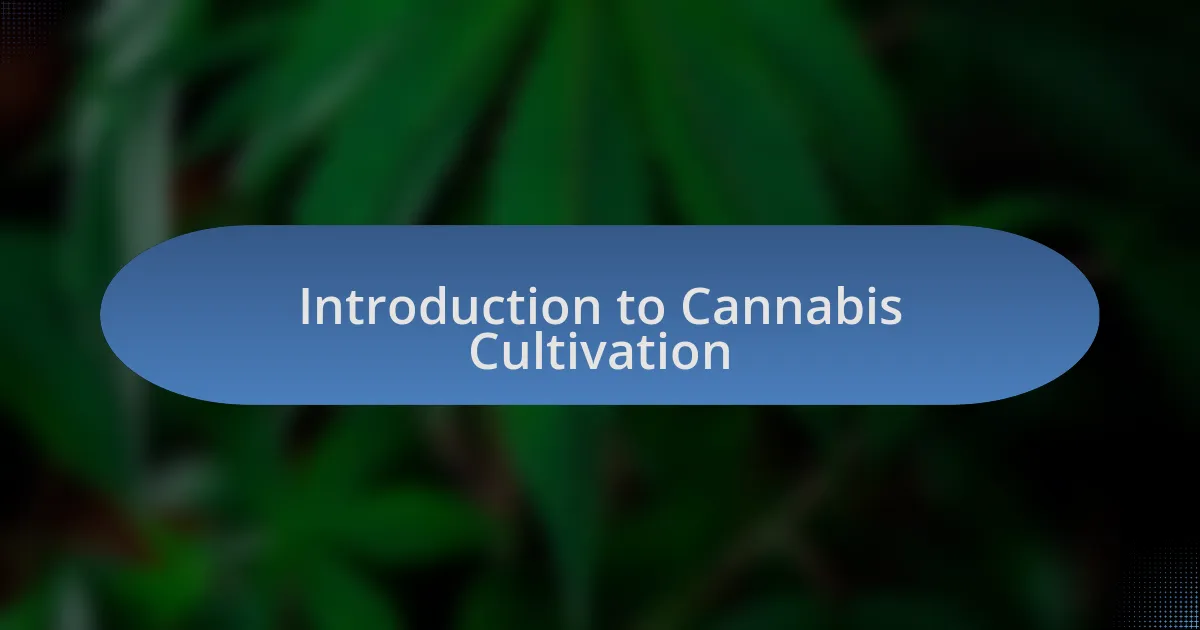
Introduction to Cannabis Cultivation
Diving into cannabis cultivation is more than just growing a plant; it’s a journey filled with discovery, patience, and a deep connection to nature. I still remember my first seedling sprouting – it felt like a small miracle, fueling my desire to learn and grow further. Each stage of the cultivation process, from germination to harvest, offers unique challenges that taught me to appreciate the delicate balance of science and artistry involved.
As I honed my skills, I often wondered how many others had embarked on a similar path and what lessons they’d learned along the way. The truth is, every grower’s experience is different, shaped by their environment, techniques, and what they hope to achieve. This diversity in cultivation methods can lead to vibrant discussions about soil health, nutrient management, and lighting techniques, all of which play critical roles in plant health and yield.
Reflecting on my own cultivation adventures, I’ve realized that successful cannabis cultivation requires not just technical knowledge, but also a willingness to adapt and experiment. Whether it’s tweaking the pH of the soil or trying different lighting setups, each decision affects the final outcome. Does it always work out perfectly? Not at all! But the learning process is what makes this journey worthwhile and fulfilling.
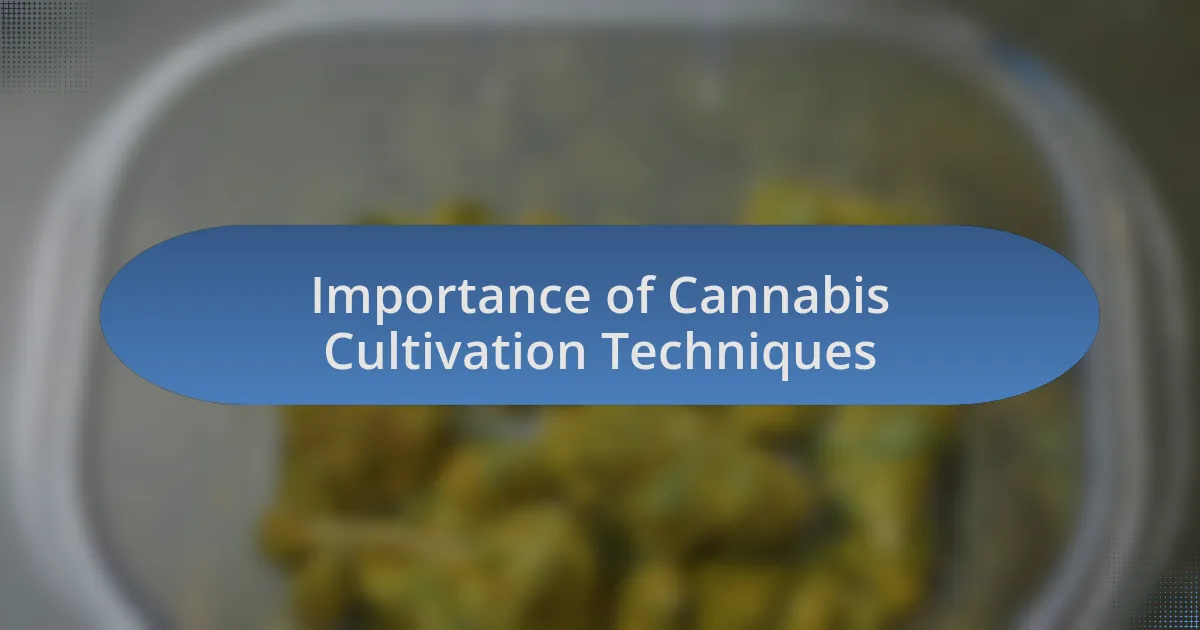
Importance of Cannabis Cultivation Techniques
Mastering cultivation techniques is essential not just for optimizing yields but also for ensuring the quality of the final product. I vividly recall a time when I experimented with organic fertilizers versus synthetic ones. The difference in the aroma and potency was striking, underscoring how the choices we make during cultivation profoundly impact the overall experience of the harvest. Isn’t it incredible to think that with the right techniques, a simple seed can transform into something truly remarkable?
When I first delved into different training methods like low-stress training (LST), I found it to be a gamechanger in maximizing light exposure and bud development. I was astonished at how a few gentle bends in the plant could lead to a more abundant harvest. This hands-on experience taught me that employing the right techniques not only enhances growth but also makes the process more engaging and fulfilling. Who doesn’t want to feel connected to their plants in a way that goes beyond just watering them?
Moreover, as I navigated through various growing environments—be it indoors or outdoors—specific cultivation techniques revealed themselves as vital tools for success. For instance, controlling humidity levels indoors made a world of difference in preventing mold issues. Reflecting on these moments, I realize that cultivating cannabis is an art that intertwines science and intuition. Isn’t it remarkable how each technique unveils another layer of understanding, transforming us into better growers?

Overview of Cannabis Expo Events
Attending Cannabis Expo events is an eye-opening experience for anyone involved in the cannabis industry. I remember my first Expo vividly; the energy was electric, with passionate growers and innovators all gathered to share their knowledge. It’s fascinating to witness how diverse perspectives on cultivation techniques can spark new ideas, challenging the way we think about our own practices.
These events often feature an array of workshops and panels, allowing attendees to dive deep into specific cultivation methods. I once attended a session focused on advanced hydroponic systems, and I was captivated by the potential for increased yields and faster growth cycles. It was like unlocking a new dimension in my cultivation journey, reinforcing the idea that there’s always more to learn and discover.
Networking opportunities at Cannabis Expo events can lead to invaluable connections and collaborations. I still remember meeting an experienced cultivator who shared detailed insights into pest management techniques that I had never considered before. This kind of exchange highlights the Expo’s role as a hub for cultivating not just plants, but also relationships and knowledge, making it an essential stop for anyone passionate about cannabis.
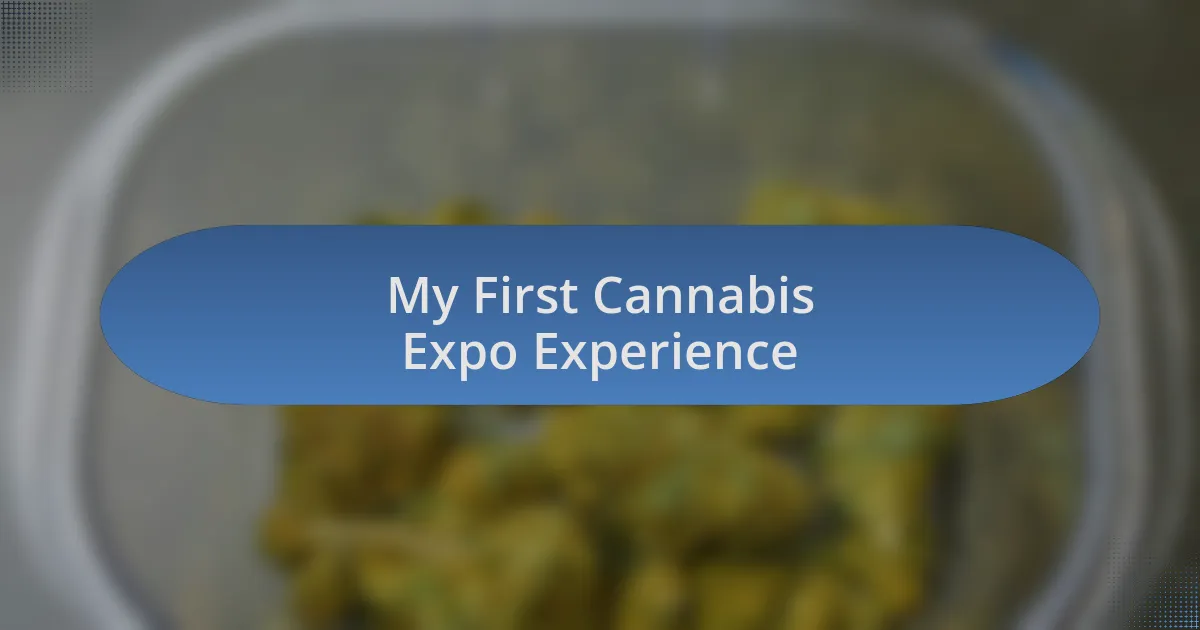
My First Cannabis Expo Experience
Walking into my first Cannabis Expo felt like stepping into a dream I hadn’t realized I was dreaming of. The sheer variety of booths and displays took my breath away; each corner seemed to reveal a new breakthrough or cultivation technique that could change my approach entirely. I remember feeling a sense of belonging amidst the buzz of conversations—a realization that I was part of an incredible community of like-minded enthusiasts.
During the Expo, I was drawn into a discussion about organic pest control methods, led by a charismatic expert with a wealth of knowledge. Listening to their journey and experiences, I found myself genuinely inspired. How often do we get to hear stories that resonate so deeply, reminding us why we embarked on this journey in the first place? The personal touch in their tales encouraged me to rethink my practices and explore alternatives I had previously overlooked.
One moment stood out: while mingling at a networking session, I found myself chatting with a fellow cultivator who shared a hilarious mishap involving a soil mix gone wrong. We both laughed, but underneath that humor was a shared understanding of the challenges we face. It reinforced the idea that we’re all navigating this ever-evolving landscape together, learning from our blunders and celebrating our triumphs. Can there be a better way to foster growth, both in plants and in ourselves?
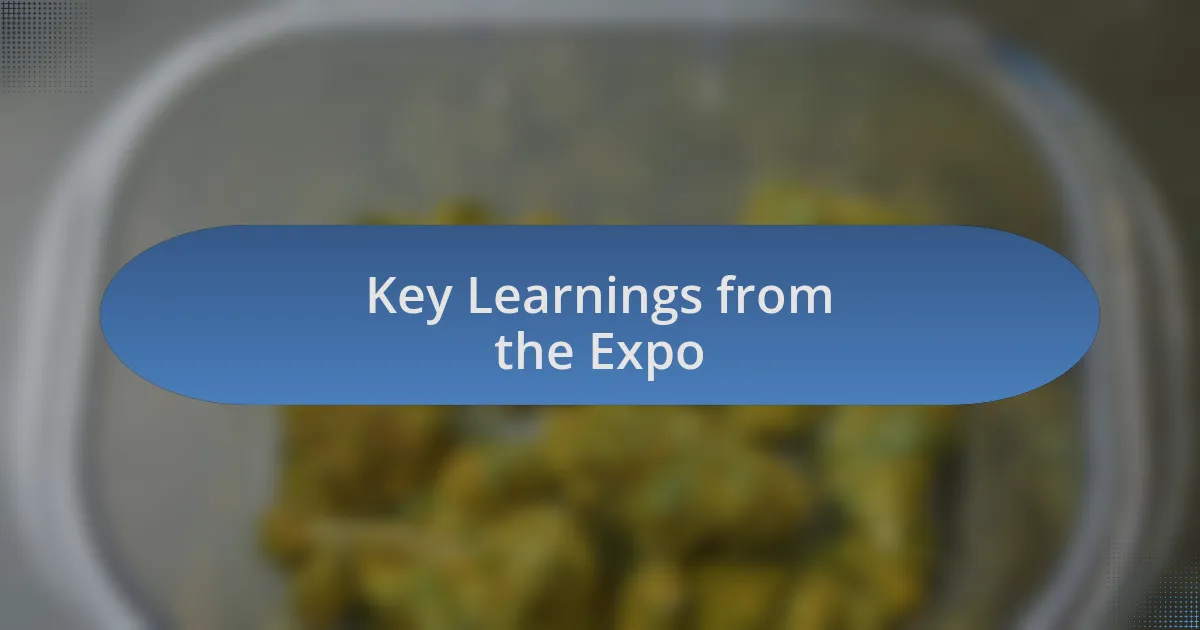
Key Learnings from the Expo
Reflecting on my time at the Expo, I realized how invaluable hands-on demonstrations can be. I remember participating in a workshop about different hydroponic systems, where seeing the setup in action transformed my understanding entirely. It’s one thing to read about these techniques, but witnessing them firsthand made all the difference in grasping their nuances and advantages.
One of the most surprising insights came from a session on the psychological effects of different strains. The speaker connected the dots between cultivation practices and consumer experiences, prompting me to think about the end product in a new light. It made me wonder: how often do we, as cultivators, consider the emotional journey our plants take from seed to harvest? This perspective shift deepened my appreciation for the craft and encouraged me to explore the intricacies of cultivation with a more holistic approach.
Networking at the Expo opened my eyes to the power of community knowledge. I struck up a conversation with an experienced grower about their trial and error with lighting techniques. Listening to their stories not only validated my own struggles but also sparked ideas for improvements in my setup. Isn’t it fascinating how shared experiences can guide us in ways we never imagined? Engaging with others has truly highlighted the importance of collaboration in this ever-evolving field.
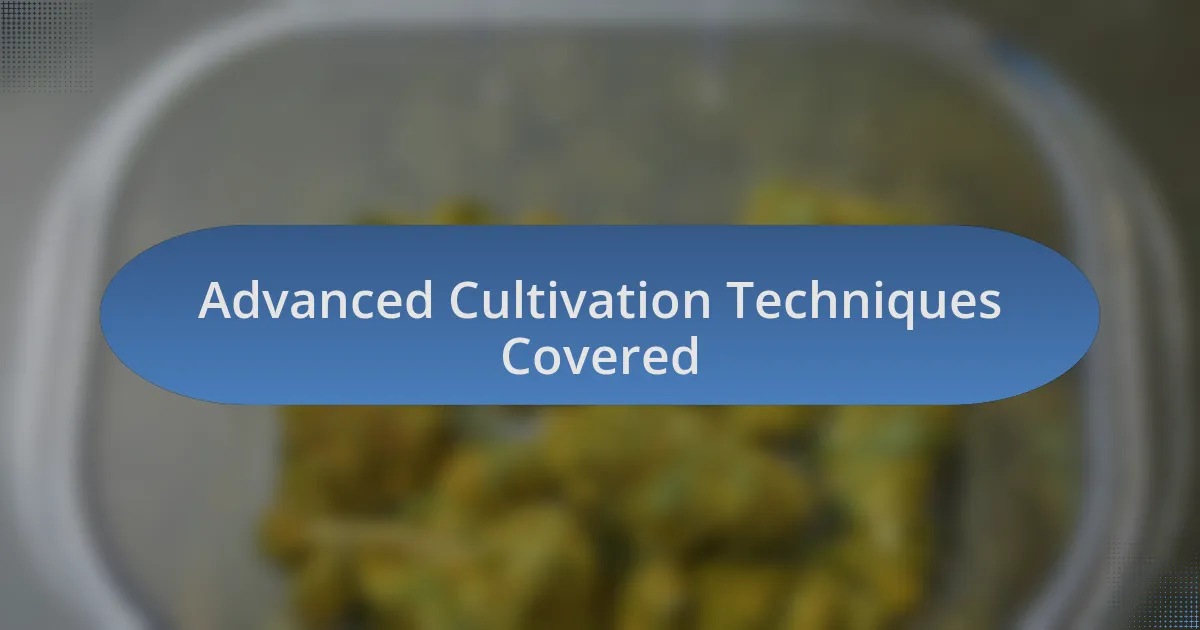
Advanced Cultivation Techniques Covered
When diving into advanced cultivation techniques, I found myself fascinated by the art of low-stress training (LST). During a workshop, an expert showcased how gently bending and tying down branches can enhance light exposure and, ultimately, yield. This method felt so intuitive to me, as if I was nurturing the plant’s natural growth while simultaneously giving it a helping hand. Have you ever seen a plant thrive simply because it was given the right support?
Another topic that really captivated my attention was the use of advanced nutrient management systems. I recall a discussion on employing automated systems to tailor nutrient delivery according to plant needs. Hearing successful growers share their experiences of adjusting pH and nutrient levels based on real-time data was enlightening. It made me think: how much more could we achieve if we let technology work alongside our instinctive understanding of plants?
Finally, I was particularly drawn to the innovations in pest management strategies. One speaker emphasized the importance of integrating beneficial insects into the ecosystem. As they described releasing ladybugs and predatory mites, I couldn’t help but feel excited about the potential for natural solutions. It left me pondering: wouldn’t it be incredible if we could cultivate in harmony with nature, turning pests into allies rather than adversaries? This idea resonated deeply with me, highlighting a path toward sustainable cultivation.
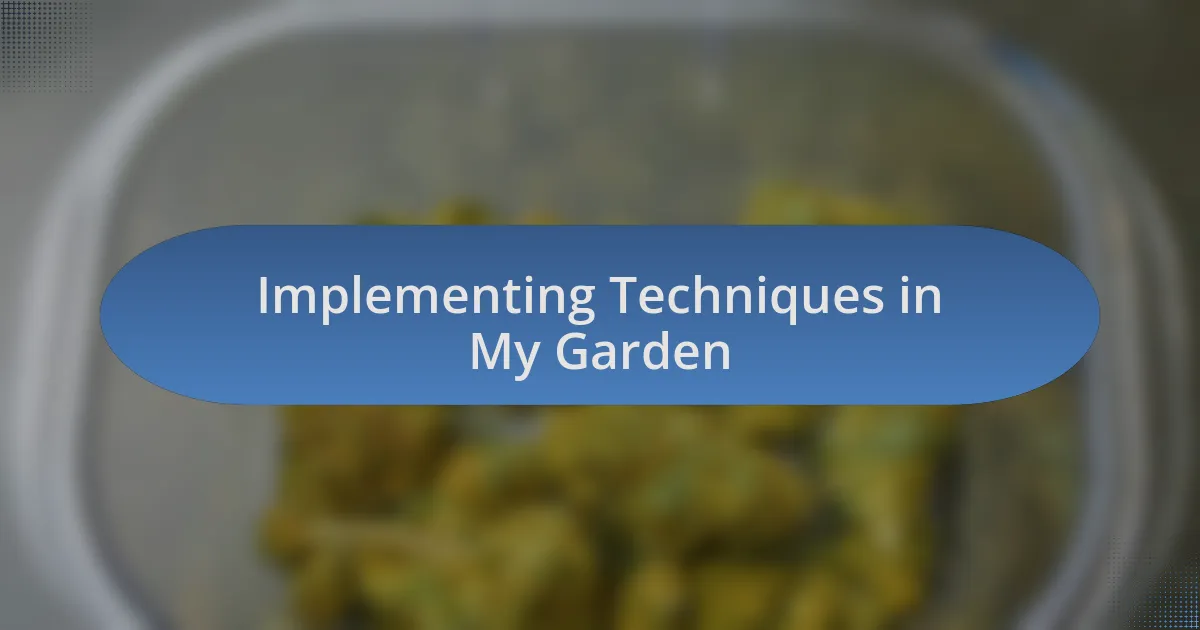
Implementing Techniques in My Garden
In my garden, I started incorporating low-stress training (LST) right away. The first time I bent a branch, I felt a thrill, as if I was unlocking the plant’s potential. Watching the foliage flourish and fill out made me realize how responsive they can be to thoughtful guidance—it’s like a dance of trust between the gardener and the plant.
When I decided to implement a nutrient management system, it felt like stepping into a whole new realm. I vividly remember the first time I adjusted pH levels based on the readings from my sensors. It felt powerful and almost like I was having a conversation with my plants, responding to their needs as they communicated through their leaves. How satisfying is it to witness them thrive exactly when they get the right mix of nutrients?
Pest management became an inspiring journey of its own. The day I released ladybugs into my garden was unforgettable—I watched them explore their new environment with a sense of purpose. It was a heartwarming experience, transforming what could feel like a battle into a partnership with nature. Doesn’t it make you think about the possibilities of a harmonious garden ecosystem, where every creature plays a role?